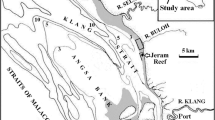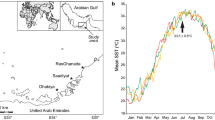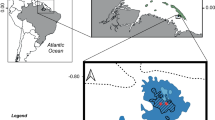Synopsis
Subtidal studies of fish stocks conducted along a rock breakwater in Southern California reveal a rich and diverse fauna with elements from cool and warm temperate regions. More than 100 species have been observed with half of these resident. Only a single large, permanently territorial species occurs on the reef though many small, often cryptic species defend home and/or reproductive sites. Many of the larger, mobile species orient to temperature stratification and a portion of the diversity can be allied to the ecotonal effect of stable stratification. Both large predators and herbivores are rare; the majority of the species are micropredators, grazing on sedentary or benthic microinvertebrates.
Reproduction is keyed to spring-summer seasons, generally with pelagic eggs, embryos and larvae. The live-bearing resident embiotocids show the least fluctuation in numbers while many oviparous species have shown major changes in annual success during the study period. Although the success of individual species varies, the diversity and total abundance of fishes has remained relatively stable for the reef community as a whole. This stability cannot be considered to reflect an equilibrium community and in fact the structure of the community has changed significantly during the five year study.
Similar content being viewed by others
References cited
Barlow, W. 1981. Patterns of parental investment, dispersal and size among coral-reef fishes. Env. Biol. Fish. 6: 65–85.
Bray, R. N. & A. W. Ebeling. 1975. Food, activity, and habitat of three ‘picker type’ microcarnivorous fishes in the kelp forests off Santa Barbara, California. U.S. Fish. Bull. 73: 815–829.
Clarke, T. A. 1970. Territorial behaviors and population dynamics of a pomocentrid fish, the garibaldi,Hypsypops rubicundus. Ecol. Monogr. 40: 189–212.
Connell, J. H. 1975. Some mechanisms producing structure in natural communities: a model and evidence from field experiments. pp. 460–492. In: J. Cody & J. M. Diamond (ed.) Ecology and Evolution of Communities. Belknap Press, Harvard Univ., Cambridge.
Ebeling, A. W. & R. N. Bray, 1976. Day versus night activity of reef fishes in a kelp forest off Santa Barbara, California. U.S. Fish. Bull. 74: 703–717.
Ehrlich, K. F., I. M. Houd, G. Muszynski & G. E. McGowen, 1979. Thermal behavioral responses of selected California littoral fishes. U. S. Fish. Bull. 76: 837–849.
Ehrlich, K. F. J. S. Stephens, Jr., G. Muszynski & J. M. Hood, 1979. Thermal behavioral responses of the speckled sanddab,Citharichthys stigmaeus: laboratory and field investigations. U. S. Fish. Bull. 76: 876–972.
Ehrlich, P. R. & A. H. Ehrlich, 1973. Coevolution: heterotypic schooling in Caribbean reef fishes. Amer. Nat. 107: 157–160.
Ellison, J. P. C. Terry & J. S. Stephens, Jr. 1979. Food resource utilization among five species of embiotocis at King Harbor, California, with preliminary estimates of caloric intake. Mar. Biol. 52: 161–169.
Houston, M. 1979. A general hypothesis of species diversity. Amer. Nat. 113: 81–101.
Love, M. & A. W. Ebeling 1978. Food and habitat of three switch-feeding fishes in the kelp forests off Santa Barbara, California. U. S. Fish. Bull. 76: 257–271.
Marshall, N.B. 1953. Egg size in Arctic. Antarctic and deep-sea fishes. Evolution 7: 328–341.
Molles, M.C. Jr. 1978. Fish species diversity in model and natural reef patches: experimental insular biogeography. Ecol. Monogr. 48: 289–305.
Paine, R. T. 1966. Food web complexity and species diversity. Amer. Nat. 100: 65–75.
Poole, R. W. 1974. An introduction to quantitative ecology. McGraw-Hill, New York 532 pp.
Roughgarden, J. 1974. Species packing and the competition function with illustrations from coral reef fishes. Theoret. Pop. Biol. 5: 163–186.
Sale, P. F. 1977. Maintenance of high diversity in coral reef fish communities. Amer. Nat. 111: 337–359.
Sale, P. F. & R. Dybdahl, 1975. Determinants of community structure for coral reef fishes in an experimental habitat. Ecology 56: 1343–1355.
Smith, C. L. & J. C. Tyle, 1972. Space resource sharing in a coral reef fish community. Bull. Natur. Hist. Mus., Los Angeles County 14: 125–190.
Stephens, J. S., Jr. & J. P. Ellison. 1977, A study of fish food habits as related to the biological enrichment of an area. Sea Grant-Fish Food Habits Symposium: 19–24.
Stephens, J. S., Jr. & J. B. Palmer. 1979. Can coastal power stations be designed to offset impacts by habitat enrichment? Mitigation Symposium, Fort Collins, Colorado: 446–450.
Talbot, F. H. B. C. Russell & G. R. V. Anderson. 1978. Coral reef communities: unstable, high-diversity systems? Ecol. Monogr. 48: 425–440.
Terry, C. B. & J. S. Stephens, Jr. 1976. A study of the orientation of selected embiotocid fishes to depth and shifting seasonal vertical temperature gradients. Bull. So. Calif. Acad. Sci. 75: 170–183.
Verner, J. 1977. On the adaptive significance of territoriality. Amer. Nat. 111: 769–775.
Author information
Authors and Affiliations
Rights and permissions
About this article
Cite this article
Stephens, J.S., Zerba, K.E. Factors affecting fish diversity on a temperate reef. Environ Biol Fish 6, 111–121 (1981). https://doi.org/10.1007/BF00001805
Received:
Accepted:
Issue Date:
DOI: https://doi.org/10.1007/BF00001805




